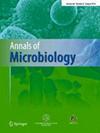利用分离自 TA2 的酿酒酵母和分离自 HCJ2F-19 的 Wickerhamomyces anomalus 共同发酵甘蔗糖蜜生产生物乙醇
IF 3.4
4区 生物学
Q2 BIOTECHNOLOGY & APPLIED MICROBIOLOGY
引用次数: 0
摘要
共培养是一种广泛使用的方法,可提高富含可发酵糖的生物质的生物乙醇产量。本研究旨在通过 S. cerevisiae 分离物 TA2 和 W. anomalus 分离物 HCJ2F-19 的同时共发酵,从甘蔗糖蜜中生产生物乙醇。采用基于中央复合设计(CCD)的响应面方法(RSM)优化发酵条件,包括搅拌速率(110-150 rpm)、温度(25-35 °C)、糖蜜浓度(25-35 obrix)和培养时间(36-72 h)。乙醇浓度通过配备紫外检测器的高效液相色谱进行分析。与 W. anomalus 分离物 HCJ2F 在实验室条件下分别产生 14.5 g.L-1、0.30 g.g-1 和 0.28 g.L-1.h-1 乙醇、乙醇产量和生产率相比,单培养 S. cerevisiae 分离物 TA2 产生的乙醇产量为 17.2 g.L-1,乙醇产量为 0.33 g.g-1,生产率为 0.36 g.L-1.h-1。与 S. cerevisiae TA2 和 W. anomalus HCJ2F 的单一培养相比,使用这两种分离物进行联合发酵的乙醇产量分别比单一菌种发酵提高了 29% 和 53%。结果表明,在联合发酵过程中,W. anomalus HCJ2F-19 和 S. cerevisiae TA2 的生长互不影响。在 pH 值为 5.5、25 obrix、48 h、150 rpm、30 °C、接种物比例为 60:40、总接种量为 10%的条件下,通过一次一变量优化(OVAT)分析,乙醇浓度为 26.5 g.L-1,比产量和生产率分别为 0.46 g.g-1、0.55 g.L-1.h-1。在 30 Obrix、30 °C、54 h 和 130 rpm 条件下,使用 RSM-CCD 工具进行联合发酵,获得的最大乙醇浓度为 35.5 g.L-1。结果表明,在最佳发酵条件下,分离自 TA2 的 S. cerevisiae 和分离自 HCJ2F 的 W. anomalus 共同发酵提高了甘蔗糖蜜的生物乙醇产量。本文章由计算机程序翻译,如有差异,请以英文原文为准。
Bioethanol production from sugarcane molasses by co-fermentation of Saccharomyces cerevisiae isolate TA2 and Wickerhamomyces anomalus isolate HCJ2F-19
Co-culturing is a widely used method to improve bioethanol production from biomass enriched in fermentable sugars. This study aims to produce bioethanol from sugarcane molasses by simultaneous co-fermentation of S. cerevisiae isolate TA2 and W. anomalus isolate HCJ2F-19. Response surface methodology (RSM) based on the central composite design (CCD) was employed to optimize fermentation conditions, including mixing rate (110–150 rpm), temperature (25–35 °C), molasses concentration (25–35 obrix), and incubation time (36–72 h). The ethanol concentration was analyzed using HPLC equipped with a UV detector. The monocultureS. cerevisiae isolate TA2 produced 17.2 g.L−1 of ethanol, 0.33 g.g−1 of ethanol yield, and 0.36 g.L−1.h−1 of productivity compared to W. anomalus isolate HCJ2F that produced 14.5 g.L−1, 0.30 g.g−1 and 0.28 g.L−1.h−1 ethanol, ethanol yield, and productivity under laboratory conditions, respectively. In comparison to single cultures of S. cerevisiae TA2 and W. anomalus HCJ2F, the co-fermentation using both isolates showed an increased ethanol yield of 29% and 53% compared to the single species fermentations, respectively. The results showed that the growth of W. anomalus HCJ2F-19 and S. cerevisiae TA2 was not influenced by each other during the co-fermentation process. The one variable at a time optimization (OVAT) analysis resulted in an ethanol concentration of 26.5 g.L−1 with a specific yield and productivity of 0.46 g.g−1, 0.55 g.L−1.h−1, respectively, at pH 5.5, 25 obrix, 48 h, 150 rpm, 30 °C, 60:40 inoculum ratio, and 10% overall inoculum size. The maximum ethanol concentration of 35.5 g.L−1 was obtained by co-fermentation using the RSM-CCD tool at 30 obrix, 30 °C, 54 h, and 130 rpm. The results suggested that the co-fermentation of S. cerevisiae isolate TA2 and W. anomalus isolate HCJ2F improves bioethanol production from sugar cane molasses under optimum fermentation conditions.
求助全文
通过发布文献求助,成功后即可免费获取论文全文。
去求助
来源期刊

Annals of Microbiology
生物-生物工程与应用微生物
CiteScore
6.40
自引率
0.00%
发文量
41
审稿时长
3.2 months
期刊介绍:
Annals of Microbiology covers these fields of fundamental and applied microbiology:
general, environmental, food, agricultural, industrial, ecology, soil, water, air and biodeterioration.
The journal’s scope does not include medical microbiology or phytopathological microbiology.
Papers reporting work on bacteria, fungi, microalgae, and bacteriophages are welcome.
Annals of Microbiology publishes Review Articles, Original Articles, Short Communications, and Editorials.
Originally founded as Annali Di Microbiologia Ed Enzimologia in 1940, Annals of Microbiology is an official journal of the University of Milan.
 求助内容:
求助内容: 应助结果提醒方式:
应助结果提醒方式:


